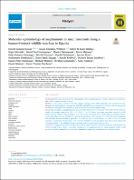| dc.contributor.author | Kasozi, Keneth Iceland | |
| dc.contributor.author | Welburn, Susan Christina | |
| dc.contributor.author | El-Saber Batiha, Gaber | |
| dc.contributor.author | Marraiki, Najat | |
| dc.contributor.author | Nalumenya, David Paul | |
| dc.contributor.author | Namayanja, Monica | |
| dc.contributor.author | Matama, Kevin | |
| dc.contributor.author | Zalwango, Kelly Katenta | |
| dc.contributor.author | Matovu, Wycliff | |
| dc.contributor.author | Zirintunda, Gerald | |
| dc.contributor.author | Ekou, Justine | |
| dc.contributor.author | Kembabazi, Stellamaris | |
| dc.contributor.author | Mugasa, Claire Mack | |
| dc.contributor.author | Kitibwa, Annah | |
| dc.contributor.author | Tayebwa, Dickson Stuart | |
| dc.contributor.author | Musinguzi, Simon Peter | |
| dc.contributor.author | Mahero, Michael | |
| dc.contributor.author | Ssengendo, Ibrahim | |
| dc.contributor.author | Nanteza, Anne | |
| dc.contributor.author | Matovu, Enock | |
| dc.contributor.author | MacLeod, Ewan Thomas | |
| dc.date.accessioned | 2024-03-20T13:08:34Z | |
| dc.date.available | 2024-03-20T13:08:34Z | |
| dc.date.issued | 2020-12-04 | |
| dc.identifier.issn | 2405-8440 | |
| dc.identifier.uri | http://hdl.handle.net/20.500.12280/3073 | |
| dc.description.abstract | Information as regards the epidemiology of the Anaplasmataceae in small ruminants in several lowand middle-income countries is scarce.
In this study a total of 712 DNA samples collected from small ruminants were analyzed for Anaplasmataceae and Anaplasma ovis using the 16S rRNA and MSP4 genes respectively. Infection risk was assessed by
location, sex and age of the animals and qGIS® was used to construct spatial maps.
The prevalence of Anaplasmataceae spp was 89.1% (95% CI: 77.5–95.9) and 79.1% (95% CI: 75.9–82.1) in
ovines and caprines respectively (RR ¼ 1.1, 95% CI: 1.0–1.3); higher than those previously reported in other
eastern African countries. The prevalence of A. ovis was 26.1% and 25.4% for both ovines and caprines respectively with ovines showing significantly higher levels of infection than caprines (P < 0.05). The risk of Anaplasma
ovis infections was not affected by age (OR ¼ 1.2, 95% CI: 0.9–1.7) or sex (OR ¼ 1.1, 95% CI: 0.6–2.0). Small
ruminants located at the forest edge (<0.3 km) showed higher A. ovis prevalence than those found inland with
infections present in the midland regions associated with increased agricultural activity.
Anaplasma ovis remains a major challenge for small ruminant husbandry in Uganda and infections are
under-reported. Policy efforts to prioritize management of Anaplasmataceae for small ruminant health would
promote livestock productivity in vulnerable communities, improving livelihoods and ecosystem health. | en_US |
| dc.language.iso | en | en_US |
| dc.publisher | Elsevier | en_US |
| dc.relation.ispartofseries | Heliyon;7 (2021) e05688 | |
| dc.subject | Tick-borne diseases | en_US |
| dc.subject | Anaplasma ovis | en_US |
| dc.subject | Parasites | en_US |
| dc.subject | Small ruminants | en_US |
| dc.subject | Goats | en_US |
| dc.subject | Uganda | en_US |
| dc.subject | Africa | en_US |
| dc.subject | Ticks | en_US |
| dc.subject | Tick resistance | en_US |
| dc.subject | Tick vaccines | en_US |
| dc.subject | Entomology | en_US |
| dc.subject | Ecosystem services | en_US |
| dc.subject | Protozoa | en_US |
| dc.subject | Polymerase chain reaction | en_US |
| dc.subject | Epidemiology | en_US |
| dc.subject | Veterinary medicine | en_US |
| dc.subject | Animal behavior | en_US |
| dc.subject | Animal breeding | en_US |
| dc.subject | Ruminant | en_US |
| dc.subject | Agriculture | en_US |
| dc.title | Molecular epidemiology of anaplasmosis in small ruminants along a human-livestock-wildlife interface in Uganda | en_US |
| dc.type | Article | en_US |


